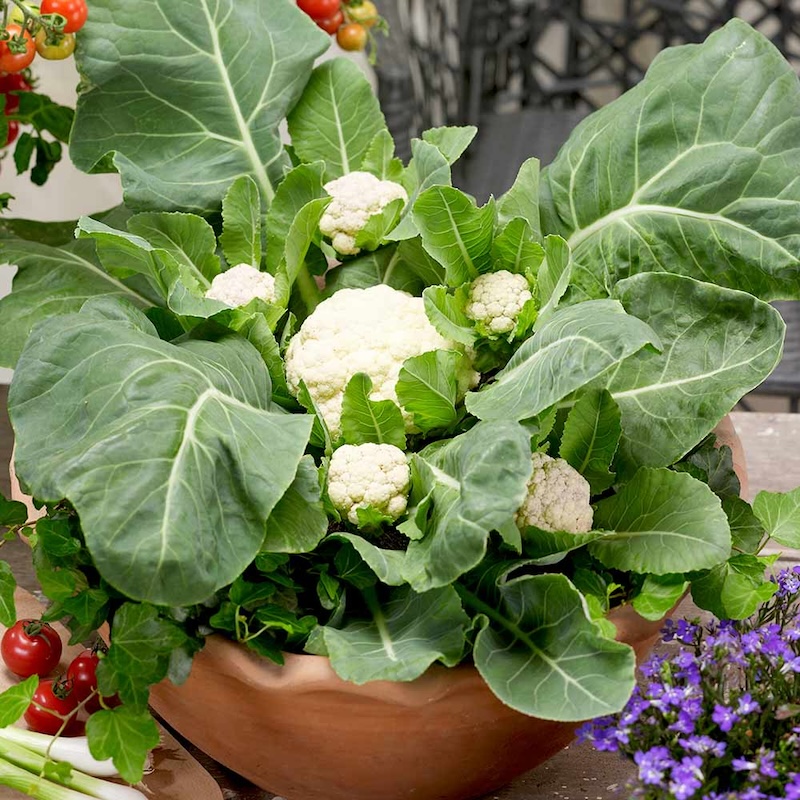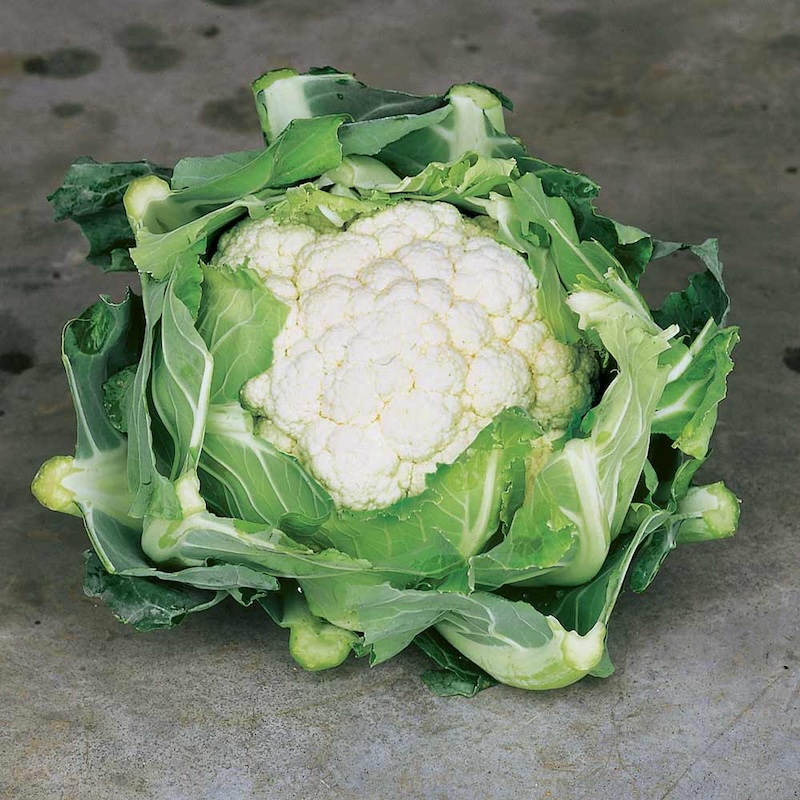Some people believe that cauliflowers are tricky to grow but, provided you plant them in the right spot and keep them well-watered, you should get a healthy crop. Homegrown cauliflowers come in a variety of gorgeous colours and delicate, nutty flavours, and sowing cauliflower seeds allows you to try unusual varieties that aren’t available in supermarkets. Here, experienced allotment grower Lee Senior shares his top tips on growing cauliflowers.
Best cauliflower varieties to grow
If I had to choose just one, Cauliflower ‘All the year Round’ is my undisputed champion. Although in some ways this timeless classic has been superseded by newer varieties, ‘All the year Round’ has a proven track record. It can be sown anytime between early February and early July, and some gardeners even sow the seed in autumn for overwintering in a cold frame and transplanting in spring. Extremely versatile, it produces good quality white heads that freeze well.
For sheer value for money and longevity, the white-coloured Cauliflower F1 ‘Multi-Headed’ offers something a little different. One large-sized head is produced as normal, but then something remarkable happens! This cut-and-come again variety then produces up to five smaller side heads on the same plant. These snack-sized mini caulis are a real bonus crop, and are a good way to get children interested!
If some of the more unusual varieties take your fancy (and why not!) try Cauliflower ‘Di Sicilia Violetto’. It produces a striking purple crown which has a sweet, slightly nutty flavour, looks great on your allotment and is sure to be a talking point.
If you prefer to start your veg from plug plants, the Cauliflower ‘Romanesco Continuity Collection’ saves time and effort. Cropping for a period of around three months, it includes three different lime green romanesco type varieties: ‘Colosseo’, ‘Gitano’ and ‘Lazio’. The architectural, pointy florets are very tasty and look the part too.
Finally, I always greatly enjoy crops out of season, and the first cauliflower to harvest in the New Year is usually Cauliflower F1 ‘Medallion’. The beautiful snow-white coloured heads are cold-resistant and can be ready from February in mild winters from a June sowing.
How to sow cauliflower seeds
This Italian heirloom cauliflower produces a striking purple crown
Image: Cauliflower ‘Di Sicilia Violetto’ Seeds from Suttons
My preferred method is to sow cauliflower seeds successionally from late February through to early April in gentle heat. Fill a seed tray with seed compost and place on a windowsill or in a heated propagator. A minimum of 12C (54F) is required for a decent germination rate, but up to 15C (60F) is ideal. Sow the seeds thinly at a depth of several millimetres and cover with sieved compost.
When the seedlings are big enough to prick out, pot them on into 3 inch (7.5cm) pots and allow them to grow on until they have four true leaves.
From April to the end of June (depending on the variety) cauliflower seeds can also be sown directly outdoors in a prepared seed bed. Protection from slugs and cold winds is a must.
How to transplant cauliflower plugs and seedlings

These lime-green heads have an excellent flavour
Image: Cauliflower ‘Romanescu Early’ Seeds from Suttons
Seedlings should be grown on in warm and sheltered conditions but don’t subject the young plants to extreme heat or too much direct sunshine in a greenhouse or cold frame.
- When your plants have 4 true leaves you can harden them off and plant them out. I like to plant them into holes lined with multi-purpose compost to help them establish quickly.
- If you’ve ordered cauliflower plug plants, water them well on arrival and check if they need hardening off.
- Plant young cauliflowers firmly to deter the cabbage root fly from laying eggs. Use a collar around the stems to give even better protection against this troublesome pest.
- Keep young plants well watered.
- If the weather turns cold after planting out, I like to cover my plants with fleece to provide a slightly warmer microclimate while they are establishing.
Where to grow cauliflowers

This unique ‘cut and come again’ cauliflower can be grown in containers or the ground
Image: Cauliflower F1 ‘Multi-Headed’ Seeds from Suttons
Cauliflowers require an open, sunny aspect. They don’t perform well in shade or exposed, windswept areas. To get good-sized heads, I tend to allocate the best soil I have on my allotment to this crop. It’s even worth planning a bed in advance for use the following year if you have the space. This gives you time to increase soil fertility and remove all annual and perennial weeds.
The plants need plenty of space to develop if you want good-sized heads. Leave approximately one and a half feet (50cms) between the plants and at least 2ft (60cm) between rows. Plant a little closer if you prefer smaller heads.
How to care for cauliflowers

This superb tasting variety also freezes well
Image: Cauliflower ‘all the year round’ Seeds from Suttons
It’s perfectly possible to successfully grow cauliflowers from seed or plug plants, but they are a little more exacting with their requirements than the majority of other vegetables.
There are two key requirements for cauliflowers. As they’re quite a hungry crop, the first is good soil fertility. This can be achieved by creating a humus-rich soil, containing plenty of well-rotted organic matter. A soil with a PH slightly on the alkaline side is also beneficial.
The other key requirement is to provide plenty of moisture throughout all stages of growth. When planting out, it’s critical to keep the young plants moist. It’s also very important not to let the plants dry out while they’re growing and developing as this can lead to small almost unusable ‘golf ball’ sized heads.
Cover the cauliflowers carefully with fine netting to prevent attack by ravenous caterpillars that develop from eggs laid by the cabbage white butterfly. If you leave any gaps the butterflies are experts at finding any holes or weaknesses in your defences through which to lay their eggs.
Just before cropping time, bend the leaves over the heads to prevent discoloration from the sun and protect them from weather damage.
How to avoid common cauliflower problems

This exceptional autumn cauliflower is club root resistant
Image: Cauliflower F1 ‘Clapton’ Seeds from Suttons
- Poor soil: This is the number one cause of failure with cauliflowers. If you don’t have a patch of good quality soil, then this is something to work on before you start your crop. Cauliflowers will not perform well in arid soil or in soil lacking fertility.
- Too much heat or sun: Scorching your seedlings prevents them from developing properly. Keep them at the right temperature while growing on.
- Voracious caterpillars: The cabbage white butterfly is a major pest. Prevent it from laying eggs on your plants by covering them with fine netting.
- Cabbage root fly: The maggots of this common pest eat the roots of your plants and often the first sign of distress is when your cauliflower plants wilt for no apparent reason. Press collars tightly around the stems to prevent the fly from laying its eggs.
- Clubroot: This common soil-borne disease can decimate a crop. Look for resistant varieties where possible. Also ensure your soil has a good alkaline PH reading. Employing good crop rotation should also help.
- Slugs and snails: I’ve seen trays of seedlings and newly planted specimens wiped out literally overnight, so it’s important to provide protection.
We hope we’ve inspired you to try growing cauliflowers at home. Succession sow your seeds in batches, every couple of weeks so your crop doesn’t all mature at once. For more of Lee’s practical, hands-on, vegetable growing advice, visit his monthly allotment pages.
